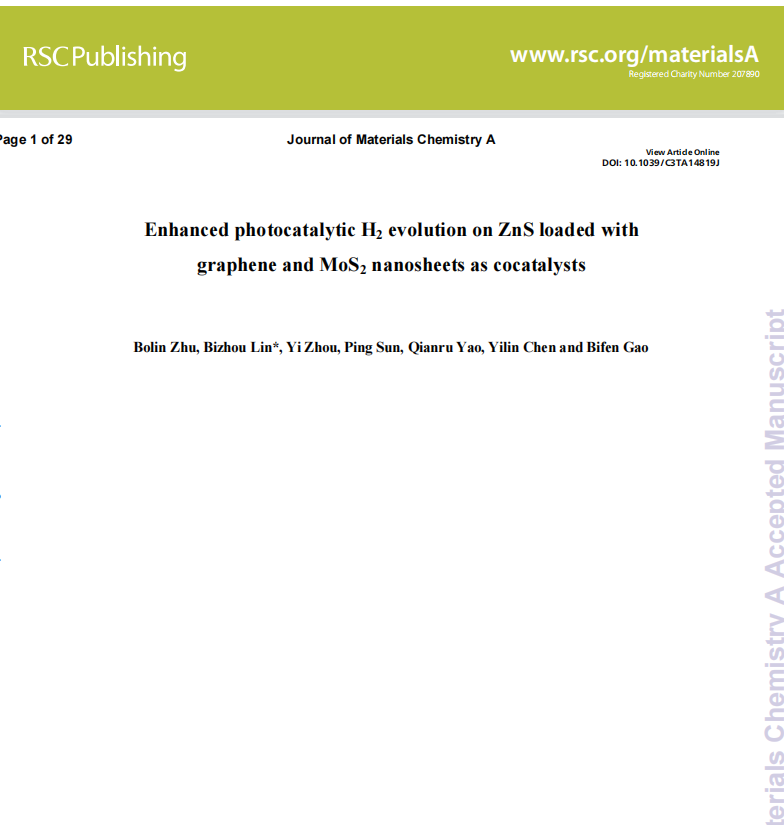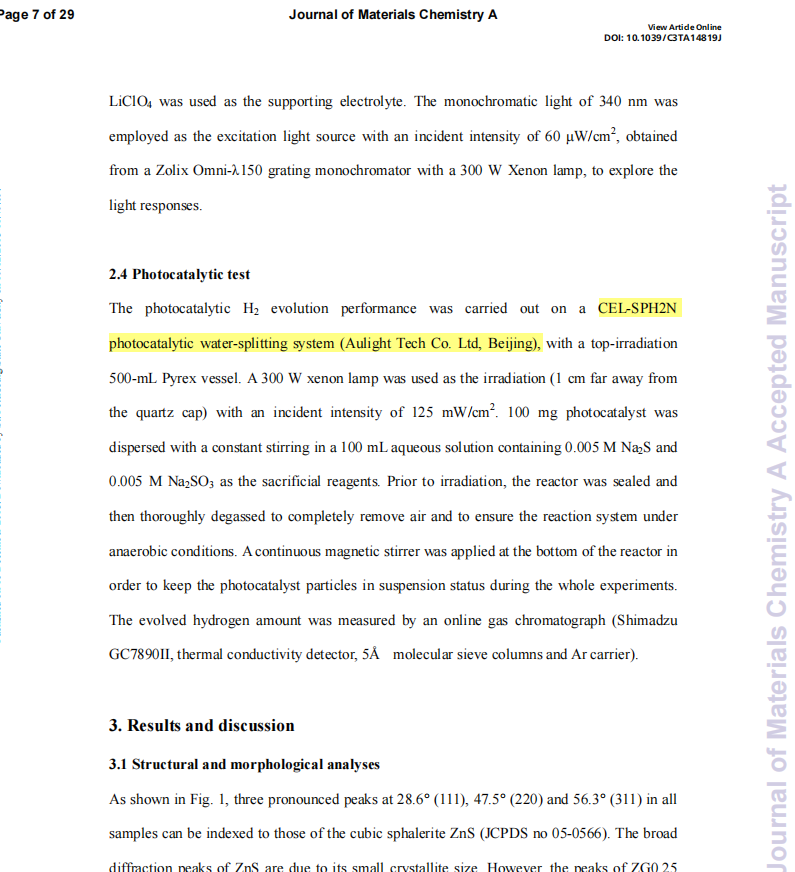Service hotline
+86 18518316054
 Current location : Home page > Resources > Papers > Enhanced photocatalytic H2 evolution on ZnS loaded with graphene and MoS2 nanosheets as cocatalysts
Current location : Home page > Resources > Papers > Enhanced photocatalytic H2 evolution on ZnS loaded with graphene and MoS2 nanosheets as cocatalysts
ABSTRACT
Graphene and MoS2 nanosheets modified ZnS nanoparticles was successfully prepared by a simple one-pot hydrothermal route in the presence of graphene and MoS2 nanosheets. The resultant ZnS/graphene/MoS2 nanocomposites exhibited significantly enhanced photocatalytic activity and good recurrence stability in H2 evolution from water splitting. When the loading content of graphene was 0.25 wt% and that of MoS2 was 2 atom%, the ZnS/graphene/MoS2 nanocomposite reached a high H2-evolution rate of 2258 µmol·h–1·g–1 under a 300-W Xe lamp irradiation, which is about 2 times that of ZnS alone. The synergistic effect of cocatalysts contribute to the high performance of the hybrid photocatalyst, where graphene serves as an excellent electron acceptor and transporter, and MoS2 nanosheets provides a source of active reactive sites. It demonstrates that the exfoliated MoS2 nanosheets, achieved by the liquid exfoliation from natural molybdenite, can be used as one of efficient cocatalysts to prepare high-performance photocatalysts in hydrogen evolution from water splitting.
2. Experimental
2.1 Preparation of photocatalysts
All the reagents were of analytical-grade and were used as received without further purification. Graphene oxide (GO) was prepared by a modified Hummers’ method from natural graphite powder.28 Typically, a 9:1 mixture of concentrated H2SO4/H3PO4 (130:14 mL) was added to the mixture of graphite powder (1.0 g) and KMnO4 (6.0 g) and then heated to 50°C with stirring for 12 h. The mixture was subsequently cooled to room temperature and poured onto ice (~250 mL) with 30% H2O2 (2 mL). The resultant mixture was centrifuged (9000 rpm for 15 min) and washed for several times with distilled water, 30% HCl and ethanol. The remaining solid was then dispersed with distilled water (200 mL) under ultrasonication at room temperature for 30 min to obtain the exfoliated GO nanosheets. A small amount of incompletely exfoliated particles was removed away using a centrifugation at 300 rpm for 10 min.
The exfoliated MoS2 nanosheets were synthesized by a solvothermal method.27 Firstly, 0.5 g MoS2 and 0.5 M n-butylithium (15 mL) were added to n-hexane (35mL) in a 100 mL Teflon-lined stainless steel autoclave and heated at 100°C for 5 h. The product (LixMoS2) was rinsed three times with n-hexane and dried in vacuum at 50°C for 10 h. Secondly, 0.1 g LixMoS2 was hydrolysed in 200 ml water (pH = 4, adjust with HNO3) under ultrasonication for 60 min at room temperature to produce a colloidal suspension of MoS2 nanosheets.
The ZnS/graphene/MoS2 composites were synthesized by a hydrothermal method. Zn(Ac)2·2H2O and Na2S were used as the precursors of ZnS. Firstly, 0.3 g sodium dodecylsulfate (SDS) was added to the distilled water (25 mL) to form a solution. Prior to the addition of GO suspension and MoS2 nanosheets suspension, 0.88 g Zn(Ac)2·2H2O was dissolved in the SDS solution. Subsequently, Na2S (0.2 M, 20 mL) was added dropwise to the mixture with stirring for 60 min and then transferred into a Teflon-lined autoclave and heated at 160°C for 2 h. The precipitates were collected and washed thoroughly with distilled water and ethanol for three times. Finally, the resultant products were dried at 60°C in vacuum over night. As discussed later, partial graphene oxide were reduced under the hydrothermal conditions, and are referred as RGO (shortened for reduced graphene oxide). By varying the addition amount, ZnS/graphene/MoS2 nanocomposites with different RGO and MoS2 amount were prepared. Hereinafter, ZnS with RGO (wt %) alone and MoS2 nanosheets (atom% of metal elements) alone were respectively denoted as ZGx (x = 0.1, 0.25, 0.5, 1.0) and ZMx (x = 0.5, 1, 2, 4), and ZnS with 0.25% GO (wt%) and MoS2 (atom%) was referred as ZGMx (x = 1.0, 2.0, 4.0).
2.4 Photocatalytic test
The photocatalytic H2 evolution performance was carried out on a CEL-SPH2N photocatalytic water-splitting system (Aulight Tech Co. Ltd, Beijing), with a top-irradiation 500-mL Pyrex vessel. A 300 W xenon lamp was used as the irradiation (1 cm far away from the quartz cap) with an incident intensity of 125 mW/cm2 . 100 mg photocatalyst was dispersed with a constant stirring in a 100 mL aqueous solution containing 0.005 M Na2S and 0.005 M Na2SO3 as the sacrificial reagents. Prior to irradiation, the reactor was sealed and then thoroughly degassed to completely remove air and to ensure the reaction system under anaerobic conditions. A continuous magnetic stirrer was applied at the bottom of the reactor in order to keep the photocatalyst particles in suspension status during the whole experiments. The evolved hydrogen amount was measured by an onli GC7890II, thermal conductivity detector, 5Å molecular sieve columns and Ar carrier).


3. Results and discussion
3.1 Structural and morphological analyses
As shown in Fig. 1, three pronounced peaks at 28.6° (111), 47.5° (220) and 56.3° (311) in all samples can be indexed to those of the cubic sphalerite ZnS (JCPDS no 05-0566). The broad diffraction peaks of ZnS are due to its small crystallite size. However, the peaks of ZG0.25 have become narrower significantly, and a small peak appears at 33.1° is observed, which can be ascribed to the (002) facet of cubic ZnS. The narrower peaks indicate that the average crystallite size of ZnS in ZG is bigger than that of the bare ZnS, demonstrating that a certain amount of graphene may promote the growth and aggregation of ZnS nanoparticles (Fig. S1 in the Supplementary Information). However, in the presence of MoS2 nanosheets and in the coexistence of graphene and MoS2 nanosheets under the hydrothermal preparation conditions, all of the obtained ZM and ZGM composites exhibited broad diffraction peaks, similar to the bare ZnS. Such broadening is enough to shield the (002) reflection, similar to the previous reports.29 The broad diffraction peaks suggest that the presence of MoS2 nanosheets prevented the crystallite growth of ZnS. The small crystallite size is favorable for the improvement in surface area. The average crystallite sizes of ZnS particles for typical samples are listed in Table 1, calculated from the 28.6° peak by the Scherrer’s formula. It should be pointed out that no apparent peaks for graphene or MoS2 were observed because of their lower loading content and weak crystallization. However, their existence can be clearly identified by HRTEM, XPS and Raman spectra as discussed later.
TEM and HRTEM images were taken to directly analyze the microscopic morphology and structural information of ZGM composites. As documented in Fig. 2, although some graphene are curly, most of them are functioned as the supported platform for the deposition of exfoliated MoS2 nanosheets and the growth of the ZnS nanoparticles. The compositions in ZGM2, ZnS, graphene and MoS2, have been integrated by the way of intimated interfacial contact. It was supported by FT-IR spectra (Fig. S2), where the featured 659 cm–1 of Zn–S stretch for ZnS was shifted to 664 cm–1 and 615 cm–1 of Mo–S stretch for MoS2 to 620 cm–1 in ZGM2. The intimated contact is expected to form a desirable heterostructure, which will lead to more efficient electron transfer between the adjacent components. The lattice fringes presented in different directions can be clearly observed in a same area (Fig. 2C). The lattice spacing of about 0.31 nm can be ascribed to the (111) plane of cubic ZnS, and the spacing of about 0.27 nm to the (100) plane of hexagonal MoS2. The latter demonstrates the atomic lattices in the MoS2 basal planes, suggesting that the MoS2 sheets lay flat on the graphene. The content of MoS2 in ZGM2 determined by EDS (Fig. S3) was 2.18 atom%, which is in good agreement with the addition amount. As depicted in Fig. 2C, each agglomerated ZnS nanoparticle presents almost the same size, indicating the growth of ZnS nanoparticles may be possible upon Ostwald ripening.29 The mechanism is responsible for the nucleation of ZnS small particles as well as the dissolution of small crystals which are deposited onto larger crystals, which results in the uniform size under the employed conditions.